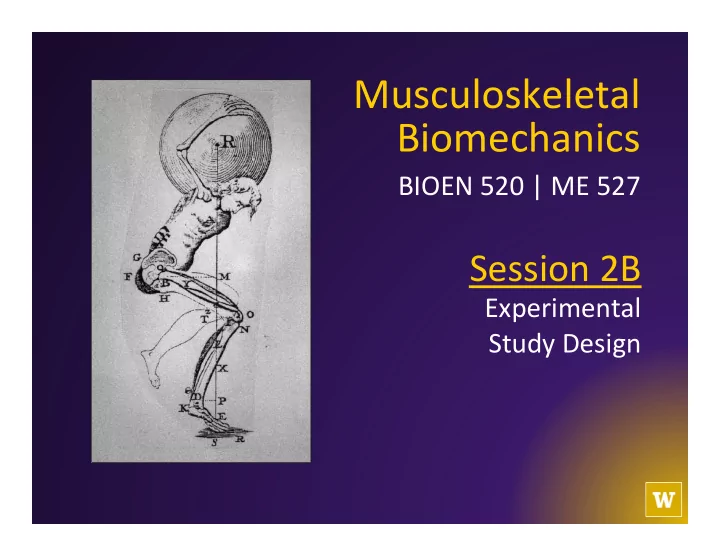

Musculoskeletal ¡ Biomechanics ¡ BIOEN ¡520 ¡| ¡ME ¡527 ¡ Session ¡2B ¡ Experimental ¡ ¡ ¡ Study ¡Design
Review: ¡Session ¡2A... ¡ • ¡Reviewed ¡basic ¡concepts ¡in ¡engineering ¡ mechanics ¡ • ¡Examined ¡viscoelasJcity ¡and ¡how ¡it ¡relates ¡to ¡ biomechanics ¡
Session ¡2B... ¡ [Q]: ¡What ¡is ¡the ¡ “ ScienJfic ¡Method ” ? ¡ [Q]: ¡What ¡study ¡designs ¡are ¡typically ¡used ¡in ¡ biomechanical ¡research? ¡ [Q]: ¡What ¡two ¡key ¡input/output ¡variables ¡are ¡ used ¡in ¡biomechanics? ¡ [Q]: ¡From ¡these ¡variables, ¡what ¡metrics ¡can ¡be ¡ derived ¡and ¡used ¡in ¡characterizing ¡/ comparing ¡biomechanical ¡properJes? ¡ [Q]: ¡What ¡experimental ¡models ¡are ¡commonly ¡ used ¡in ¡biomechanics ¡research? ¡
Session ¡#3... ¡ [Q]: ¡How ¡do ¡we ¡begin ¡to ¡ “ apply ” ¡mechanics ¡to ¡ the ¡musculoskeletal ¡system? ¡ ¡ ¡ - We know the anatomy we want to study... � - We know basic engineering mechanics... � What ¡should ¡we ¡consider ¡when ¡designing ¡a ¡study? ¡ ¡
The ¡ “ ScienJfic ¡Method ” ... ¡ [Q]: ¡Did ¡you ¡ever ¡do ¡a ¡ “ Science ¡Fair ” ¡project? ¡
The ¡ “ ScienJfic ¡Method ” ... � [Q]: ¡What ¡is ¡the ¡ “ ScienJfic ¡Method? ” ¡ - Identify a question... � [Observation] � - Develop a hypothesis... � [Hypothesis] � - Test the hypothesis... � [Experimentation] � - Interpret the results... � [Interpretation] �
The ¡ “ ScienJfic ¡Method ” ... ¡ Flowchart... ¡ Observation [Q]: ¡Does ¡all ¡ research ¡ Hypothesis follow ¡this ¡ process? ¡ Experiment Repeat Revise Results Supports Doesn ’ t Support Hypothesis Hypothesis Scientific Theory
Basic ¡vs. ¡Applied ¡Research... � [Q]: ¡What ¡is ¡the ¡difference ¡between ¡ “ basic ” ¡ and ¡ “ applied ” ¡research? ¡ - Basic: Hypothesis driven (...follows the scientific method to test a hypothesis) - Applied: Problem solving (...collects data to answer a specific question or optimize a solution)
Study ¡Design... ¡ [Q]: ¡What ¡types ¡of ¡study ¡designs ¡are ¡commonly ¡ used ¡in ¡biomechanics ¡research? ¡ - Controlled Laboratory Study � � (compares treatments - e.g., implant A vs. B) � - Descriptive Laboratory Study � � (describes characteristics or property - e.g., anthropometry) � - Review Study � � (no experiments - reviews existing literature) �
Study ¡Design... ¡ [Q]: ¡What ¡other ¡factors ¡should ¡be ¡considered ¡ when ¡designing ¡a ¡study? ¡ Between-‑Groups ¡Comparison ¡ - Control Group Repeated ¡Measures ¡(within ¡a ¡group) ¡ - Randomization - Prospective vs. Retrospective - Replication (a.k.a., Repeatability)
Input ¡and ¡Output ¡Variables... ¡ [Q]: ¡What ¡are ¡ “ input ” and ¡ “ output ” ¡variables... ¡ … y = sin(x) in mathematics? � … in programming? � trunc(raw, digits, return) … Independent / Dependent in research? �
Input ¡and ¡Output ¡Variables... � [Q]: ¡Based ¡on ¡our ¡definiJon ¡of ¡mechanics, ¡ what ¡are ¡the ¡2 ¡most ¡fundamental ¡input ¡ and/or ¡output ¡variables ¡for ¡a ¡ biomechanical ¡study? ¡ - Load (force or moment) � - Displacement (motion or deformation) � - Control Variables (rate, temp, age, gender, etc…) �
Metrics/Parameters... ¡ [Q]: ¡From ¡ load ¡and ¡ displacement , ¡what ¡metrics ¡ can ¡be ¡used ¡to ¡characterize ¡or ¡compare ¡ biomechanical ¡response? ¡ σ - Stress-Strain � - Stiffness / modulus � - Failure Load / Strength � - ROM / Ultimate Strain � ε - Hysteresis / Creep / Stress Relax. � - Many others (...fatigue strength, toughness, etc.) �
Experimental ¡Models... ¡ [Q]: ¡What ¡are ¡typical ¡experimental ¡models ¡used ¡ in ¡biomechanics ¡research? ¡ - Human Subjects (live volunteers)… � - Human Tissues (cadaver)... � - Animal Subjects/Tissues... � - Dummies/Manikins... � - Others Physical Models... �
Test ¡Enviroment... ¡ [Q]: ¡What ¡environmental ¡factors ¡are ¡important ¡ in ¡biomechanics ¡experiments ¡and ¡why? ¡ - Temperature � - Humidity � - Time (from tissue harvesting and no. of freeze-thaw cycles) �
Other ¡Control ¡Variables... ¡ [Q]: ¡Besides ¡environmental ¡factors, ¡what ¡other ¡ variables ¡should ¡be ¡considered/controlled? ¡ - Age � - Gender � - Size (ht./wt.) �
Sample ¡Size... ¡ [Q]: ¡How ¡can ¡we ¡determine ¡how ¡many ¡test ¡ specimens ¡to ¡test? ¡ Statistical Power Analysis -- to reduce chance of Type I (false “ + ” ) and II (false “ - ” ) errors � On-line Calculators & Programs: � Need http://statpages.org/#Power � pilot http://www.quantitativeskills.com/sisa/calculations/samsize.htm � data! http://www.gpower.hhu.de/en.html �
Study ¡Design ¡Summary… � Air ¡Cylinder ¡Example… ¡
Study ¡Design ¡Summary… � Input Variable: � Control Variables: � D = Displacement Controlled � T = Temperature � F = Force Controlled � H = Humidity � Study Type: � G = Age � C = Controlled Lab Study � A = Gender � D = Descriptive Lab Study � R = Review Paper � � Control Group: � C B R - D - HC - Cr Hy - T - B = Between Groups � W = Within Groups � 10 � Randomized: � R = Randomized � Exp. Model: � Metrics: � N � � HS = Human subject � S = Stiffness � HC = Human cadaver � M = Modulus � AS = Animal subject � ROM = Range of motion � AC = Animal cadaver � F = Failure load � O = Other � S = Strength � Cr = Creep � Sr = Stress relaxation � Hy = Hysteresis �
In-Class Group Discussion ... ¡ [Q]: ¡In ¡the ¡papers ¡by ¡Lee ¡et ¡al. ¡and ¡ Whiaaker ¡et ¡al., ¡compare ¡and ¡ contrast ¡the ¡study ¡designs ¡(including ¡ models ¡and ¡staJsJcal ¡analyses ¡used ¡ in ¡hypothesis ¡tesJng)? ¡
Recommend
More recommend